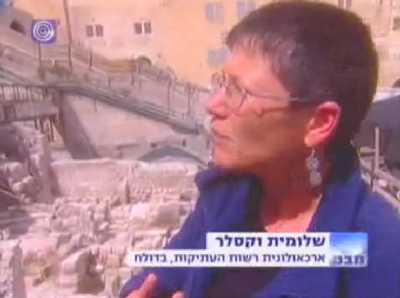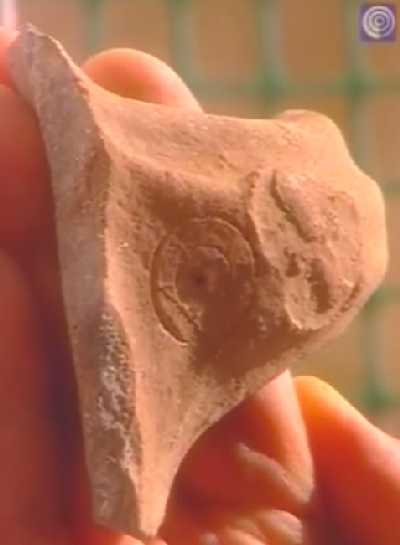To put it in perspective, it would be the equivalent of a human attempting to lift about 60 tons (which, by the way, is the approximate estimate for the largest blocks used in the Great Pyramid)!
The new observation, though, is related to the color of the beetle's shell changing between green & black, possibly relative to the humidity of its environment. However, researchers can't be certain at this time:
"As to why the beetle changes colour, question marks also remain. Some have suggested that it is to do with protection – it becomes more humid at night and is therefore good for cover to turn black. Others have suggested that it is to do with warmth absorption at night. Questions remain."
In a parallel universe at what's been called the navel of the world--Jerusalem--questions also remain about 3 jar handles found in excavations adjacent to the Western Wall's plaza (a.k.a., the Kotel; by the way, the weight of one of the master-blocks on the Temple Mount near this Wall has been estimated at about 400 tons).
Just this week, the IAA announced some preliminary findings by archeologists, Shlomit Wexler-Bdoulah & Alexander Onn. The biggest attention-getter was a tri-register personal seal (better photo available from a Ynet report; detailed drawing available in the File-library at Yahoo's Biblicalist). Coming in 2nd place was an inscribed Herodian-era stone containing a fragmentary block-style Hebrew inscription.
This stone was not mentioned in any of the online news reports. It was shown on an Israeli news TV show--Mabat (MB@)--hosted in Hebrew by a beautiful young lady (who I'm showing here in the interest of scientific research because I'm hoping someone will be able to tell me what her name is so I can properly credit her in LMLK publications, of course):

Thanks to Victor Hurowitz for bringing this
According to the IAA report, "a vast amount of pottery vessels was discovered, among them three jar handles that bear LMLK stamped impressions. An inscription written in ancient Hebrew script is preserved on one these [sic] impressions and it reads 'NURBH KLML' ([belonging] to the king of Hebron)."
Notice that the IAA included the scriptio plene rendition of the word as it appears 73 times in the Hebrew Old Testament; only 4 times is it written scriptio defectiva as on all 5 Hxx LMLK seals. One of your clues that the seal's inscription might not be referring to the same place.
I have a love/hate relationship with the IAA. I love that they take care of Israel's antiquities, & publish reports like this, & grant export permits for me to acquire specimens of these inscribed treasures; but I hate it when they're ambiguous, especially when a simple E-mail of 3 photos to me could've resolved the ambiguity in less than 24 hours.
Based on their announcement, which is an English translation from Hebrew:
- I'm not confident that they found 2 weak/fragmentary impressions as opposed to 2 LMLK-type handles with no seal impressions.
- I don't know whether the impressions have 2- or 4-winged icons.
- I don't know which of the 5 HBRN seal designs are on the one identified as such.
- I don't know whether the handles were found along with other handle- or jar-fragments to deduce whether this small hoard represents 1, 2, or 3 jars.
Like the beetle-color issue, questions remain.
The reason I question their statement about 3 handles bearing impressions, is that if they're not considerate or competent or thorough enough to identify the basic icon design (which is obvious 99.7% of the time [only 3 of 897 are xxx]), how do I know whether they're really LMLK handles?
I'll demonstrate another reason why I doubt their report's accuracy. Witness my recent discovery of a 1975 journal (which is supposed to be more accurate than this mere press release by the IAA), where 2 LMLK handles from Chephirah were described as bearing a 2-winged & a 4-winged impression, & now a few decades later, the 4-winged impression has apparently vanished--mysteriously flying away I suppose!
One of the archeologists, Shlomit Wexler describes the excavation in the 2-minute TV report:

I especially doubt the accuracy of the English IAA report because it named her as Shlomit Wexler-Bdoulah, but the original Hebrew version along with the TV report omitted the hyphenated name, & presented her as "SLUMYT UQCLR". Later in the IAA sentence, the word "Bdoulah" was used--"ARKAULUGYT RSUT EOTYQUT, BDULH" ("Archeological Authority Antiquities, Bdulh"). Now, Sunday evening, I checked it again & noticed that it was corrected to "SLUMYT UQCLR-BDULH" at some point over the past few days. Could there still be a similar word-jumble in the LMLK sentences?
To my surprise, Mabat showed one of the LMLK handles during the 32:15-32:20 section of the entire show's video feed:

(Note--I deliberately rotated the image 90 degrees clockwise to show it in the highest resolution possible under my Blogspot 400-pixel limit without affecting the rest of my page layout.)
A male Hebrew reporter, identified by Yitzak Sapir as belonging to Benny Lis, during the 5-second LMLK segment asks rhetorically (in Hebrew, translated by Sapir), "a seal - to the king of Hebron -- does it speak of King David?"
That's one question we can positively answer with a conclusive, "no". Even if the chronology of the Judean monarchy is TFU, we know from archeology that the LMLKs were in use at the time of a foreign invasion that conquered numerous cities in the region, & there were no such battles recorded in the Bible (our only reliable source of info on the reigns of Judean kings) during David's famous reign.
Now's a good time to mention that I like this TV show's watermark, which consists of concentric circles! I was shocked to see Circle-incisions on the handle too because they were not mentioned in the IAA report! A 4th strike against their reporting reliability.
What also surprised me was that I was not able to confirm the presence of an inscription or other clear identifying characteristic of the impression. This is not because the handle doesn't have one, but because of the low resolution of the video, & the highly skewed camera angle distorting the seal's design (unlike the rotated terracotta figurine shown just prior to this handle, the handle image was static).
My initial reaction was that this was probably not an H2D, even though it's the most common type (based on the number of handle-photos I've seen), & most common of types found with the Circles. Why not? Mostly because of the icon's head. The H2D's head is extremely unique among the 2-winged class, being elongated (i.e., taller/thinner) by a whole millimeter in contrast to some that are flattened (shorter/wider). Also, there are no known H2D stamps at a 7:00 orientation, which is what this one bears.
From a cursory inspection, I felt that this stamp could've been from an S2DR, which would be important because it's a rare type, & no specimens with Circles are known. However, when I scrutinized the impression for publication on the LMLK Research site Saturday morning, I noticed that it fit the M2U design best of all! What a shocker!
There's a shadow from a letter just off the top-right corner of the icon's head, & if this is from a Mem, it matches its location on the M2U, but not the S2DR or H2D; however, there's also a letter-shadow in the bottom-left register that matches the H2D's Nun, but it also matches the M2U's Tau. And if the short/wide icon-head resulted from a messy H2D stamp, then we have to consider the possibility of other features resulting from a messy/shifted stamp, such as a Z2D Fay in the bottom-left register, which resembles the H2D's Nun.
Focusing on the icon itself, there's nothing about this skewed image that contradicts the M2U design. And although its head doesn't match the H2D's, the asymmetric lower wing-joints resemble that distinct feature of the H2D (though the S2DR may also have a similar asymmetric joint, but I just don't have enough clear impressions to be certain).
So based on the evidence available to me, I'd have to say that it's a tie between the H2D & M2U, each having 3 positive indicators--the H2D having the inscription identified in the report plus a match with one of its letters & wing anomaly, & the M2U matching letters in 2 registers & matching the overall icon.
Kevin Edgecomb mentioned offline to me that just because we can't read the inscription on this particular handle, it doesn't mean that there isn't a clear "HBRN" inscription on one of the other 2 handles. He's right, but it's extremely doubtful that the archeologist would've shown this poor-inscription specimen to (pardon the expression) an ignorant news reporter while stating that some other/better specimen actually contained the "King of Hebron" inscription.
I checked with my knowledgeable LMLK friend, Michael Welch, who believes this is probably an H2D, "based on the more vertical second Lamed, probably a pretty clear final Nun, and probably the extra notch cut out on the upper right top of the two-winged sun disc icon."
I did not notice the 2nd Lamed when doing my analysis, but can see it now that he mentioned it, though I disagree on its being the more-vertical type because of the distorted camera angle. To me, it looks like the more curved type seen on the M2U! This just goes to show how 2 knowledgeable people can see the exact same thing, & form 2 different opinions.
Actually, the images we think we see are formed by our brains based on other things our individual brain has seen. We don't actually see images, we see dots of light-information (from the individual rod & cone cells), & our brain fills in the gaps with things that make sense to it. That's why most scientists who only "see" Evolution-biased scientific info presented to them in school, can only think in an Evolution-Science paradigm--they can't fill in their gaps with anything else. They're mentally disadvantaged, but I digress...
For now, I've listed it on the x2x page stating that it's probably an H2D, but possibly one of the other 3 I described above. It would be very exciting if it turns out to be an M2U, because that's the only 1 of the 5 LMLK seal sets on which there are no Circles.
Until the archeologists publish their formal excavation report (which may be months, years, or decades from now), questions remain.
Song of the week: "To The One Who Knows" by Yanni (click the song title to visit Amazon; click here for a 30-second sample; 393kb).
G.M. Grena

1 comment:
Courtesy cross-reference link to comments over at the Wordpress version.
Post a Comment